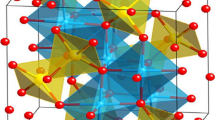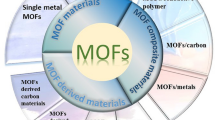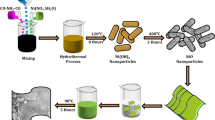Abstract
We have synthesized N-doped mesoporous carbon by the in-suit doping template method under the carbonized temperature of 900 °C. We found that the electrochemical performance of mesoporous carbon was enhanced by N-doping. So, we tried to increase the content of nitrogen to further optimize the electrochemical performance of the mesoporous carbon as electrode materials. During the process of synthesizing mesoporous carbon, the carbonized temperature played an important role in the formation of the carbon structure and its morphology, as well as in determining the content of nitrogen. We attained a considerable electrochemical performance enhancement by changing the carbonized temperature from 900 to 700 °C. We found the content of Nitrogen decreased with the increase of the carbonized temperature and the content of Nitrogen is 6.11% at 700 °C, 5.39% at 800 °C, 3.9% at 900 °C, respectively. The best electrochemical performance was observed in the product carbonized at 700 °C, which exhibited high specific capacitance (245.6 F/g at 0.5 A/g) and good cycle ability (more than 90% of the initial capacitance after 5000 cycles) in 6 M KOH electrolyte.








Similar content being viewed by others
References
Y. Shao et al., Graphene-based materials for flexible supercapacitors. Chem. Soc. Rev. 11(44), 3639–3665 (2015)
C. Zhong et al., A review of electrolyte materials and compositions for electrochemical supercapacitors. Chem. Soc. Rev. 44(21), 7431–7920 (2015)
Y. Deng et al., Review on recent advances in nitrogen-doped carbons: preparations and applications in supercapacitors. Mater. Chem. A 4(4), 1129–1532 (2016)
F. Béguin et al., Carbons and electrolytes for advanced supercapacitors. Adv. Mater. 26(14), 2219–2251 (2014)
V. Khomenko et al., High-voltage asymmetric supercapacitors operating in aqueous electrolyte. Appl. Phys. A 82(4), 567–573 (2006)
C. Arbizzani, M. Mastragostino, F. Soavi, New trends in electrochemical supercapacitors. J. Power Sources 100(1–2), 164–170 (2001)
H. Oda et al., Modification of the oxygen-containing functional group on activated carbon fiber in electrodes of an electric double-layer capacitor. J. Power Sources 158(2), 1510–1516 (2006)
T. Brousse et al., Long-term cycling behavior of asymmetric activated carbon/MnO2 aqueous electrochemical supercapacitor. J. Power Sources 173(1), 633–641 (2007)
V. Khomenko, E. Frackowiak, F. Béguin, Determination of the specific capacitance of conducting polymer/nanotubes composite electrodes using different cell configurations. Electrochim. Acta 50(12), 2499–2506 (2005)
V.D. Patake, C.D. Lokhande, Chemical synthesis of nano-porous ruthenium oxide (RuO2) thin films for supercapacitor application. Appl. Surf. Sci. 254(9), 2820–2824 (2008)
V.D. Patake, C.D. Lokhande, O.S. Joo, Electrodeposited ruthenium oxide thin films for supercapacitor: effect of surface treatments. Appl. Surf. Sci. 255(7), 4192–4196 (2009)
W. Li et al., A self-template strategy for the synthesis of mesoporous carbon nanofibers as advanced supercapacitor electrodes. Adv. Energy Mater. 1(3), 382–386 (2011)
G. Xiong et al., A review of graphene-based electrochemical microsupercapacitors. Electroanalysis 26(1), 30–51 (2014)
D. Deng et al., Toward N-doped graphene via solvothermal synthesis. Chem. Mater. 23(5), 1188–1193 (2011)
M. Deschamps et al., Exploring electrolyte organization in supercapacitor electrodes with solid-state NMR. Nat. Mater. 12(4), 351–358 (2013)
Y. Zhu et al., Carbon-based supercapacitors produced by activation of graphene. Science 332(6037), 1537–1541 (2011)
T.M. Dinh et al., High resolution electrochemical micro-capacitors based on oxidized multi-walled carbon nanotubes. J. Phys. 476(1), 012106 (2013)
X. Yang et al., Liquid-mediated dense integration of graphene materials for compact capacitive energy storage. Science 341(6145), 534–537 (2013)
J.M. Miller, B. Dunn, Morphology and electrochemistry of ruthenium/carbon aerogel nanostructures. Langmuir 15(15), 799–806 (1999)
F. Wang et al., Nitrogen-doped carbon nanofiber decorated LiFePO4 composites with superior performance for lithium-ion batteries. Ionics 22(3), 333–340 (2016)
K. Jurewicz et al., Supercapacitors from nanotubes/polypyrrole composites. Chem. Phys. Lett. 347(1), 36–40 (2001)
D.W. Wang et al., Nitrogen-doped carbon monolith for alkaline supercapacitors and understanding nitrogen-induced redox transitions. Chemistry 18(17), 5345–5351 (2012)
K. Wu, Q. Liu, Nitrogen-doped mesoporous carbons for high performance supercapacitors. Appl. Surf. Sci. 379, 132–139 (2016)
Acknowledgements
This research work was financially supported by the Shenzhen basic research (JCYJ20150417142356651) and the National Natural Science Foundation of China (51572202).
Author information
Authors and Affiliations
Corresponding author
Rights and permissions
About this article
Cite this article
Fang, J., Wu, K., Liu, Q. et al. Synthesis of N-doped mesoporous carbons under different carbonization temperature and their application in supercapacitors. J Porous Mater 25, 503–509 (2018). https://doi.org/10.1007/s10934-017-0462-6
Published:
Issue Date:
DOI: https://doi.org/10.1007/s10934-017-0462-6




